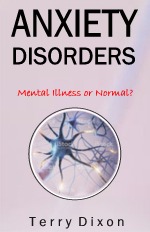|
.
|
Anxiety Disorders: Mental Illness or Normal?
Introduction
ANXIETY IS AN essential part of human make-up. A survival instinct honed over millions of years of evolution, it involves a series
of responses and reflexes that help us to avoid or deal with dangerous situations. We all have anxiety and we all need anxiety to prevent us
from getting hurt.
However for many of us, something changes: our anxiety no longer sits quietly in the background waiting to spring into action should
a potentially dangerous situation arise. It appears more often, more easily and seems to come to us for no reason – intangible anxiety that
can feel just too powerful to deal with.
Persistent anxiety causes us to watch ourselves in everything we do and it's not difficult to appreciate how this self-absorption can lead us
to believe that we are the only one with such a problem. This, in itself, strengthens the "what's wrong with me" beliefs,
yet nothing could be further from the truth.
Millions of people across the world suffer from anxiety-related problems. It's been estimated that in America alone, over fifty million people
suffer from some form of anxiety disorder. The most common one is social anxiety disorder (also called social phobia), closely followed by post
traumatic stress disorder (PTSD) and generalized anxiety disorder. Around one in thirty five to fifty people suffer from obsessive compulsive
disorder (OCD) and one in ten are reported to have a specific phobia. This doesn't include the vast numbers of people who have depression or
those living anxious lives ruled by shyness or stress.
Adding to this, many people feel they are working below their potential and are frustrated; more (and younger) people are unhealthy and
overweight than ever before; greater numbers of teenage boys and girls are severely depressed, and problems involving anxiety and stress
account for the majority of visits to a doctor's surgery. In a world of better education, food, hygiene and healthcare... emotionally,
society is crumbling.
Yet anxiety is essential to the survival of every human (indeed, every animal) on the planet. If we didn't have anxiety, we wouldn't
be scared when confronted by a knife-wielding maniac. If we didn't have anxiety, we wouldn't avoid dimly-lit alleys and underpasses
in the dead of night. Without anxiety, we wouldn't take extreme care when crossing the road with our children.
But what about anxiety-related problems?
Excessive worrying and nervousness, obsessive and compulsive behaviour, irrational fears and phobias (particularly those relating to
social interactions and having serious health problems), post-trauma stress... current beliefs about these problems (and treatments
based on these beliefs) are based on the 'medical model', which views them as illnesses, where something has gone wrong (in the brain)
and the answer lies in 'fixing' the thing that has gone wrong – usually with medication.
As such, these problems are named, defined, placed in categories and placed in sub-categories in an attempt to control them – a nicely
ordered list of problems with a neat set of symptoms. And while some argue that this offers a more accurate diagnosis and subsequent
better treatment, others argue that it's inaccurate, misleading and totally overlooks the bigger picture.
That's what this book is about... the bigger picture. The whole point of having anxiety in the first place is to protect us, and it is
this self-protection, rather than 'mental illness', that can better explain those problems we know as 'anxiety disorders' today.
In part 1 we'll look at anxiety through the lens of human evolution and survival – what is it, why do we have it and how does it work?
Part 2 describes anxiety disorders in relation to the dominant worldview (the medical model) and shows how they are defined and diagnosed.
Importantly, we'll also explore the medications that are used to treat these problems based on this belief and explain what they do to our
mind and body.
In part 3 we'll consider whether the medical model is indeed the best way to understand and deal with anxiety disorders... or is there a
better solution?
(End of Introduction)
Anxiety Disorders: Mental Illness or Normal?

This book is available in kindle and eReader formats (and can also be read on any device) for £0.99


|
.
|

|